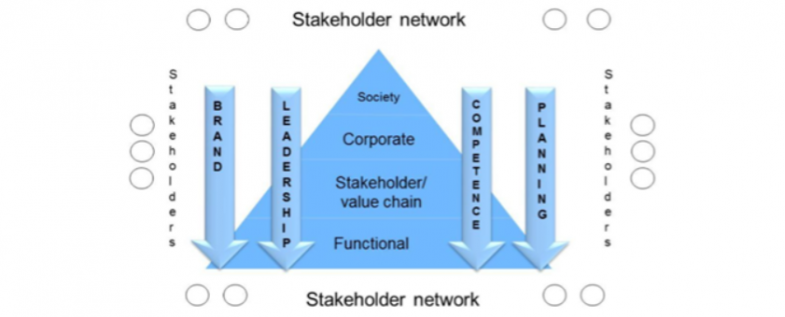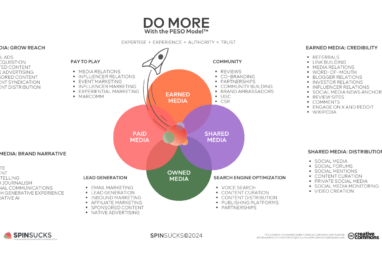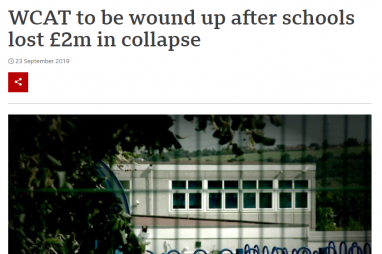Demystifying public relations for private schools
About the author
Seth Barker works as the Communication and Marketing Officer at Aiglon College, an international and independent school in Switzerland. He studied the CIPR Professional PR Diploma with PR Academy and this article was submitted as part of an assignment.

PR in Schools
What should private and independent school leaders be learning from public relations? In a world where these schools must compete in an increasingly challenging market both to attract new students and work daily within a complex web of stakeholders, private school leaders should be looking beyond the industry clichés of crisis management and spinning bad news to understand PR as a wide-reaching discipline to help develop effective communication strategies, establish schools as education leaders, meet ambitious enrolment goals and engage their stakeholder communities.

How can school leaders be encouraged to understand public relations as a strategic part of their own institution? By taking a close look at a specific model in public relations theory, we can work to pair theory with practice and shed light on how practitioners in school admissions, marketing, communications or advancement can work across all levels of their institutions to demystify the function of PR in education.
Effective school PR should encourage administrators, teachers and others to see their work as a joint responsibility that attracts, retains and enriches students while also engaging and being part of a school’s diverse fabric of stakeholders.
Theory & Practice
Oftentimes schools do not consider formal public relations an important part of their strategy because much of the PR world seems focused on international corporations, large non-profits or government entities. The perception of PR as simply “spinning” a bad story still prevails. However, in reality, most schools already practise some form of PR, even if it has not yet matured into a dedicated, strategic function.
Much like education itself, it is important to understand public relations as a discipline in which theory does not exist sheltered from practice. Theory, as Caroline Black argues, is important when thinking about how to tackle an issue, working out a plan of action or trying to understand the communication process itself. To make PR relatable in any school’s strategic thinking it is important to understand this relationship.
Proposed by PR experts Anne Gregory and Paul Willis, the four-by-four model offers a helpful way for schools to relate theory and practice. Realising that only a minority of practitioners work in the private sector, they set out to propose a model that would be functional and adaptable no matter one’s sector, like for example, education.

The four levels of the pyramid represent the different levels at which any organisation’s public relations must operate. More than individuals or specific functions, these levels represent whole “realms” in which the school or organisation must work. Each level offers significant yet distinct opportunities and challenges in which communication should play a defining role. Across the pyramid are what the authors describe as “DNA attributes” that characterise good communication at all levels. Pairing a thorough knowledge of each level’s intersection with brand knowledge, dedicated leadership, skilful competencies and effective planning are important for practitioners to both master and champion.
A key factor in examining this particular model for schools is its strong focus on stakeholder relations.
In the four-by-four model the organisation lives within a network of stakeholders that permeate all levels. This is a helpful framework for schools seeking to understand the unique role, and challenges, their stakeholders present in school communication. Who, for example, are the clients in a school that has to attract competitive students, provide an education, offer post-secondary pathways and charge tuition fees: parents or students? What is being sold by a school (if the word doesn’t cause uproar): a good university placement, exam scores, a worldview, an experience? How a teacher may answer this question is, and perhaps should be, different from a head, parent or administrator. Schools can and do spend decades wrestling with these questions.
We will now take a more practical look at how each level of the four-by-four model allows you to connect theory with practical strategies. This link should encourage a school’s PR practitioner toward a wider view of communication with a special emphasis on the unique voice school stakeholders have as an opportunity to elevate the role of strategic communication in education.
Society Level: Schools have a Voice
“Motors of unfairness” is how one headline in The Guardian describes private schools in the UK. While in the 21st century education is certainly recognised as an unquestionable good for society, this doesn’t mean every school gets a free pass on what is happening behind their gates. Many private and independent schools are under intense societal scrutiny. With rising school fees, intense competition and seemingly weekly scandals, this shouldn’t come as much of a surprise. Ignoring an issue doesn’t make it go away, and even as schools consider needed reforms, what impact can communication have?
It is at this societal level that the public relations function is perhaps at its most external and most traditional, but this should not intimidate schools. Here, the PR practitioner has the opportunity to be influential in not only clarifying a school’s values but also to monitor for disparity between these values and the actual culture. As illustrated by such headlines from The Guardian, societal legitimacy is lost when any level of the organisation fails in this profound contract between described values and lived culture.
At this level, what can practitioners do? By monitoring public opinion in local and national situations practitioners in schools can work to determine how the institution itself can move from an isolated silo to embracing its unique voice as a contributor to societal dialogue in education. For example, if many feel that private schools today are deeply unfair, why not engage stakeholders such as influential parents, hard-working teachers or high-achieving students to open a larger dialogue on what fairness means in the community and how issues can be addressed? Build a narrative of inclusivity based on one’s own values as seen in the school’s specific environment, not just distant newspapers.
Importantly, however, such legitimacy must be real and earned. It often feels that schools all say the same thing, and this is why a practitioner’s job is not to just help define a school’s values, but embrace these values as a unique culture –and then talk about it through the appropriate channels. This is all well and good a practitioner may say, but how do you get to the table where these decisions are made?
Corporate Level: A Place at the Table
A lot of work in public relations right now is focused on its role as strategic management. Gregory and Willis highlight this in the four-by-four model. The corporate level, they argue, is where organisational resources are allocated, and public relations needs a seat at that table. “The HR director will argue for the human assets required to deliver the organisational vision and the business unit director will make a case for their operational area in similar terms. Public relations should be no exception.”
In a school setting, Heather Lambie makes a similar argument for this important seat. She describes how the work of a school’s marketing and communications office has long-evolved from the days of the printed newsletter and family directory. She points out that this function has become critical to the success of a school and that often a single office becomes responsible for generating leads, marketing summer programmes, messaging for fundraising and building parent relationships. This “office of one” is no longer sufficient for even a small school to achieve its increasingly ambitious goals.
However, even when resources are tight, a school’s practitioner should champion listening to all stakeholders and promote the importance of reputation, relationships and culture.
The National School Public Relations Association (NSPRA) offers practical advice on how to get started in school PR, especially in developing a communications committee. In a situation where there may be an “office of one” with no seat at the trustee or senior table, achieving buy-in from other internal stakeholders responsible for various areas of school life can be a helpful and strategic method to build a wider understanding of PR and provide it with a greater voice.
In such a strategy it is important to both recognise the value your stakeholders bring to the table, but also the value they want to see in the school. To this end, we examine together the stakeholder and functional levels of our model alongside attributes of good communication that offer important insight in bringing school communication all together.
Stakeholder/Value Chain & Functional Levels: Making it Happen
Mapping stakeholders is a critical step to any PR planning and analysis. Practitioners, perhaps alongside their communications committee, should engage in serious planning to understand their internal and external stakeholders. In a school environment, who is responsible for these groups is not always clear. Teachers are responsible for the students, but so are parents. Teachers, administrators or trustees may have to answer to parents, but how well do they actually know that specific community? If someone is unhappy, who do they go to? Once assessed, it is then by engaging these diverse groups through the school’s functional work in its campaigns and programmes that a PR practitioner can bring all parts of the four-by-four model together.
At the functional level, stakeholders are valuable as both content producers and consumers. Blogs, newsletters and magazines are all communication channels currently used by many schools, but oftentimes just to promote “what’s happening” or update a specific group already in its echo chamber. Practitioners should be looking to use all its available channels as an opportunity to apply the four-by-four model across the school. In this way, PR becomes a unifying, community building function that doesn’t just sell programmes, but creates value for everyone. If you are interested in a model focused on cross-channel communication, Gini Dietrich has done some really interesting work in what she has named the PESO model to build public influence and visibility.
Communication activities can affirm the work of teachers by promoting innovative classroom practices to parents and prospective parents while simultaneously offering a valuable voice of leadership to other educators and alumni.
The school’s communication should become a platform that offers value across all levels of the organisational pyramid. You often hear today that big brands are becoming media companies,xiii but what can schools gain from this type of thinking? Robin Wilson in “Share This Too” points to Red Bull as the classic business-turned-media-company in a world where the wall between marketing and publishing has grown thin.
Quality magazines are one good example of publishing for schools that can embrace all stakeholders to curate and consume valuable content. However, quality and planning are keywords to avoid the dangerous tropes of bad layout and yawn-inducing, irrelevant articles. One good example is the twice annual magazine, Voices, produced by the International School of Zurich. The school uses the opportunity to cast its brand as something anyone might like to pick up. You can read in detail about classroom academics, the work of teachers and where the school is headed. Each issue features interviews across all stakeholder groups allowing parents to identify with alumni and students to connect more personally with the larger picture. The publication bleeds the school’s brand while also appealing to all levels of their community –and beyond. It’s certainly not a budget option, but its brand value is priceless and highly strategic.
The School Practitioner
Not every school may be able to afford a glossy brand piece, but in all a school’s channels, the four-by-four model should help guide practitioners toward understanding the value of stakeholder engagement across all levels of their organisation. Whether it is to monitor, and perhaps defend, societal reputation or spur dialogue at the senior table, PR in schools should not be a secondary concern relegated to the back desk of an overworked admissions office. The PR practitioner should be continually aware of and acting within a school’s society, cooperate, stakeholder and functional levels.
Properly implemented, the public relations function within a school can generate tremendous value that engages the local community, promotes the school to prospective parents while also empowering teachers with a professional, authoritative voice. Even as difficult as it may be in today’s environment to define what is or should be sold in a school, the more engagement and interest a school drives in all its stakeholders, the richer a student’s learning experience has the potential to be.


